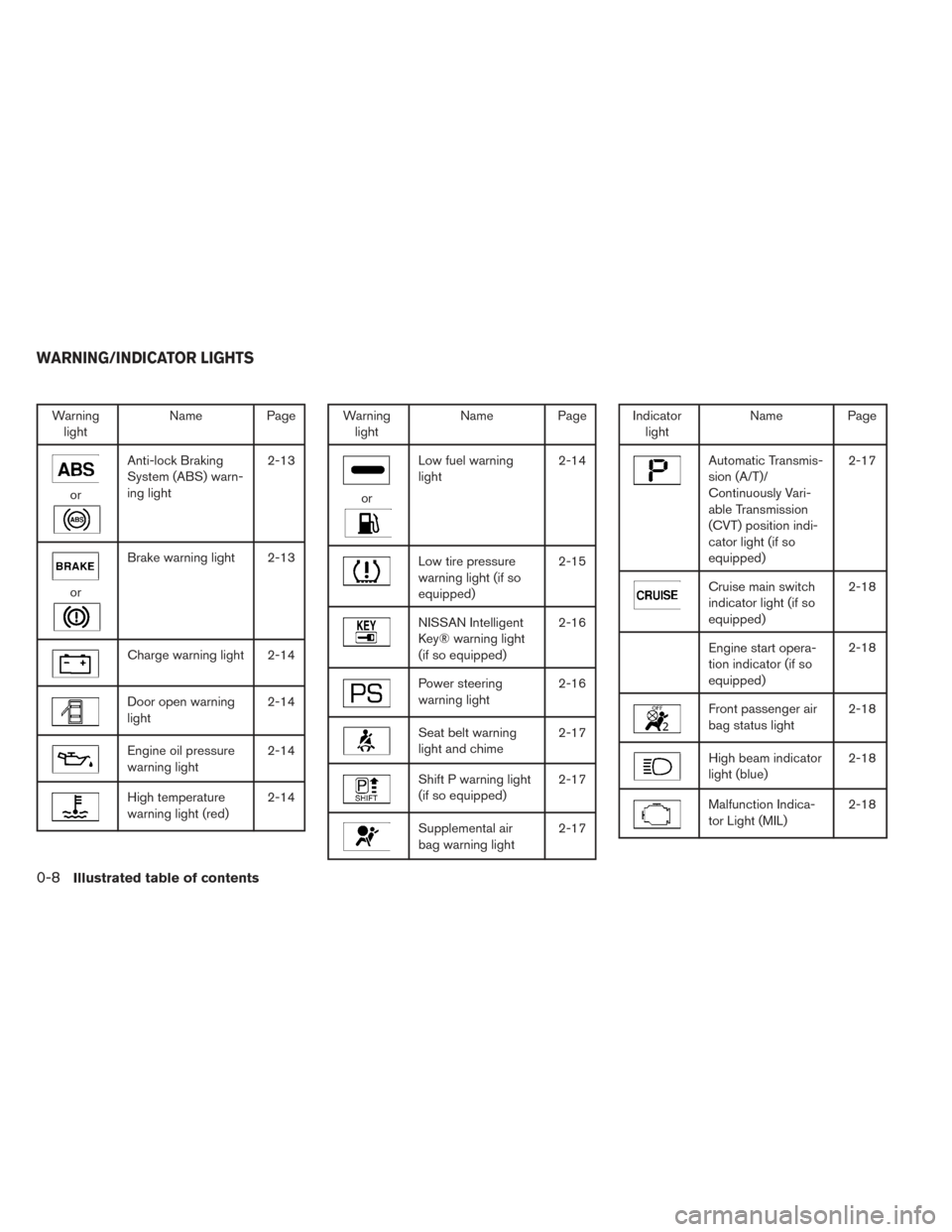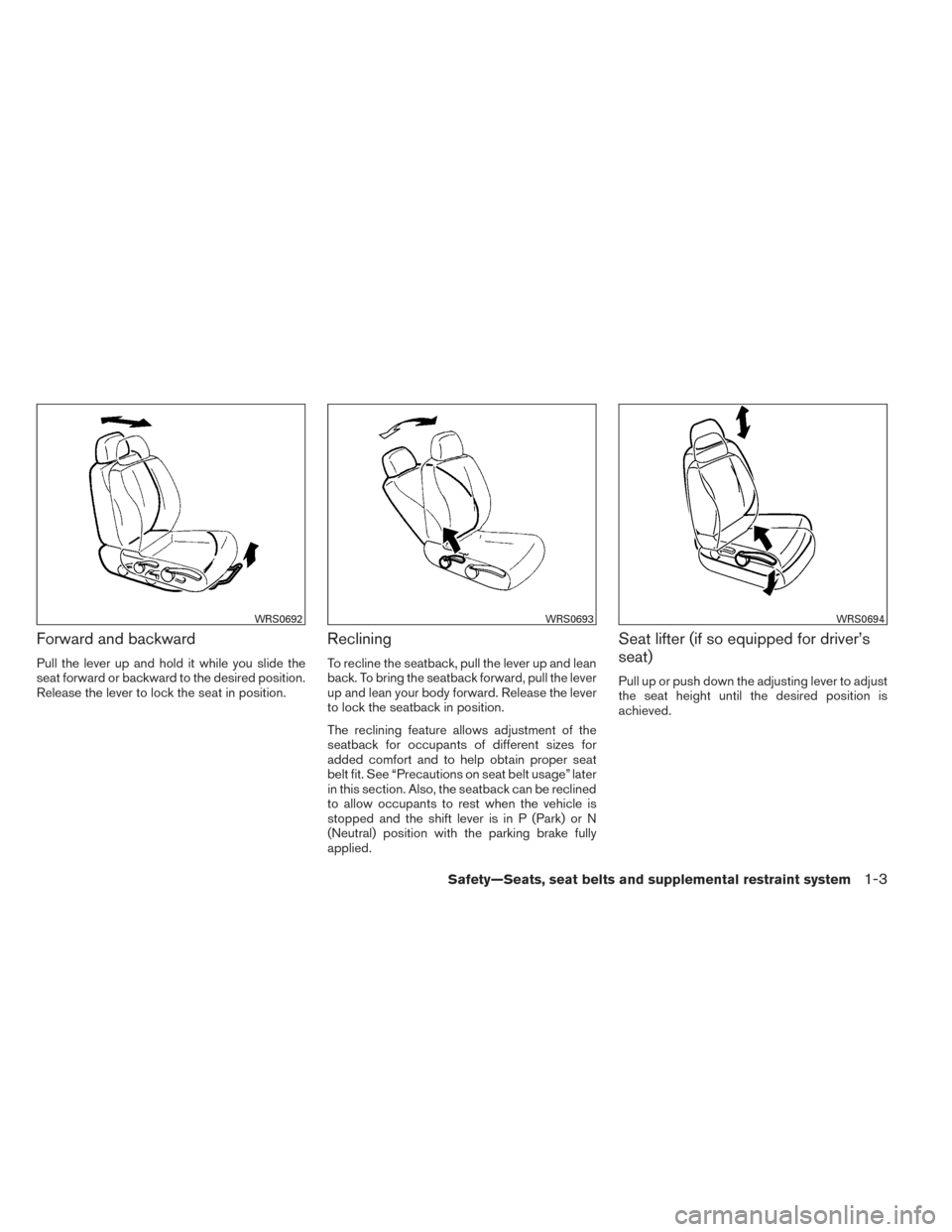Page 10 of 365
1. Engine hood (P. 3-23)
2. Windshield (P. 8-18)
3. Windshield wiper and washer switch(P. 2-21)
4. Power windows (if so equipped)
(P. 2-30)
5. Door locks, keyfob, (if so equipped) ,
keys (P. 3-5, 3-2, 3-2)
6. Mirrors (P. 3-30)
7. Tire pressure (P. 8-32)
8. Flat tire (P. 6-3)
9. Tire chains (P. 8-39)
10. Headlight and turn signal switch
(P. 2-23)
11. Replacing bulbs (P. 8-26)
12. Fog lamp switch (if so equipped)
(P. 2-25)
See the page number indicated in paren-
theses for operating details.
LII2070
EXTERIOR FRONT
Illustrated table of contents0-3
Page 11 of 365
1. Antenna (P. 4-66)
2. Rear window and outside mirror (if soequipped) defroster switch (P. 2-22)
3. Interior trunk lid release (P. 3-25 )
4. Rear view camera (if so equipped)
(P. 4-9)
5. Replacing bulbs (P. 8-26)
6. Fuel-filler door (P. 3-26)
7. Fuel-filler cap, fuel recommendation
(P. 3-26, 9-3)
8. Child safety rear door locks (P. 3-7)
See the page number indicated in paren-
theses for operating details.
LII2017
EXTERIOR REAR
0-4Illustrated table of contents
Page 15 of 365

Warninglight Name Page
or
Anti-lock Braking
System (ABS) warn-
ing light 2-13
or
Brake warning light 2-13
Charge warning light 2-14
Door open warning
light
2-14
Engine oil pressure
warning light2-14
High temperature
warning light (red)2-14
Warning
light Name Page
or
Low fuel warning
light 2-14
Low tire pressure
warning light (if so
equipped)2-15
NISSAN Intelligent
Key® warning light
(if so equipped)2-16
Power steering
warning light
2-16
Seat belt warning
light and chime2-17
Shift P warning light
(if so equipped)2-17
Supplemental air
bag warning light2-17
Indicator
light Name Page
Automatic Transmis-
sion (A/T)/
Continuously Vari-
able Transmission
(CVT) position indi-
cator light (if so
equipped) 2-17
Cruise main switch
indicator light (if so
equipped)
2-18
Engine start opera-
tion indicator (if so
equipped)2-18
Front passenger air
bag status light
2-18
High beam indicator
light (blue)2-18
Malfunction Indica-
tor Light (MIL)2-18
WARNING/INDICATOR LIGHTS
0-8Illustrated table of contents
Page 19 of 365

WARNING
●Do not ride in a moving vehicle when
the seatback is reclined. This can be
dangerous. The shoulder belt will not
be against your body. In an accident,
you could be thrown into it and receive
neck or other serious injuries. You
could also slide under the lap belt and
receive serious internal injuries. ●
For the most effective protection when
the vehicle is in motion, the seat should
be upright. Always sit well back in the
seat with both feet on the floor and
adjust the seat properly. See “Precau-
tions on seat belt usage” later in this
section.
● After adjustment, gently rock in the seat
to make sure it is securely locked.
● Do not leave children unattended inside
the vehicle. They could unknowingly ac-
tivate switches or controls. Unattended
children could become involved in seri-
ous accidents. ●
Do not adjust the driver’s seat while
driving so full attention may be given to
vehicle operation. The seat may move
suddenly and could cause loss of con-
trol of the vehicle.
● The seatback should not be reclined
any more than needed for comfort. Seat
belts are most effective when the pas-
senger sits well back and straight up in
the seat. If the seatback is reclined, the
risk of sliding under the lap belt and
being injured is increased.
CAUTION
When adjusting the seat positions, be
sure not to contact any moving parts to
avoid possible injuries and/or damage.
FRONT MANUAL SEAT
ADJUSTMENT
ARS1152
SEATS
1-2Safety—Seats, seat belts and supplemental restraint system
Page 20 of 365

Forward and backward
Pull the lever up and hold it while you slide the
seat forward or backward to the desired position.
Release the lever to lock the seat in position.
Reclining
To recline the seatback, pull the lever up and lean
back. To bring the seatback forward, pull the lever
up and lean your body forward. Release the lever
to lock the seatback in position.
The reclining feature allows adjustment of the
seatback for occupants of different sizes for
added comfort and to help obtain proper seat
belt fit. See “Precautions on seat belt usage” later
in this section. Also, the seatback can be reclined
to allow occupants to rest when the vehicle is
stopped and the shift lever is in P (Park) or N
(Neutral) position with the parking brake fully
applied.
Seat lifter (if so equipped for driver’s
seat)
Pull up or push down the adjusting lever to adjust
the seat height until the desired position is
achieved.
WRS0692WRS0693WRS0694
Safety—Seats, seat belts and supplemental restraint system1-3
Page 23 of 365
Components (if so equipped)
1. Head restraint
2. Adjustment notches
3. Lock knob
4. Stalks
Adjustment (if so equipped)
Adjust the head restraint so the center is level
with the center of the seat occupant’s ears.To raise the head restraint, pull it up.
LRS0887WRS0134LRS0888
1-6Safety—Seats, seat belts and supplemental restraint system
Page 24 of 365
To lower, push and hold the lock knob and push
the head restraint down.Removal (if so equipped)
Use the following procedure to remove the ad-
justable head restraints.1. Pull the head restraint up to the highest position.
2. Push and hold the lock knob.
3. Remove the head restraint from the seat.
4. Store the head restraint properly so it is not loose in the vehicle.
5. Reinstall and properly adjust the head re- straint before an occupant uses the seating
position.
Install (if so equipped)
1. Align the head restraint stalks with the holesin the seat. Make sure the head restraint is
facing the correct direction. The stalk with
the adjustment notches
�1must be installed
in the hole with the lock knob
�2.
2. Push and hold the lock knob and push the head restraint down.
3. Properly adjust the head restraint before an occupant uses the seating position.
LRS0889LRS0890LRS0891
Safety—Seats, seat belts and supplemental restraint system1-7
Page 25 of 365

REMOVABLE HEAD RESTRAINT (if
so equipped)
WARNING
The removable head restraints supple-
ment the other vehicle safety systems.
They may provide additional protection
against injury in certain rear end colli-
sions. Do not attach anything to the re-
movable head restraint stalks or remove
the head restraint unless it is required
when the rear seat is folded down. Do not
use the seat if the head restraints have
been removed. If the head restraint was
removed, reinstall it before an occupant
uses the seating position. Failure to fol-
low these instructions can reduce the ef-
fectiveness of the removable head re-
straint. This may increase the risk of
serious injury or death in a collision.The illustration shows the seating positions
equipped with removable head restraints. Not all
vehicles will have head restraints that are remov-
able.
�
Indicates the seating position is equipped with
a head restraint.
+ Indicates the seating position is not equipped
with a head restraint or removable headrest.
Components
1. Removable head restraint
2. Notch
3. Lock knob
4. Stalks
LRS2000LRS2224
1-8Safety—Seats, seat belts and supplemental restraint system